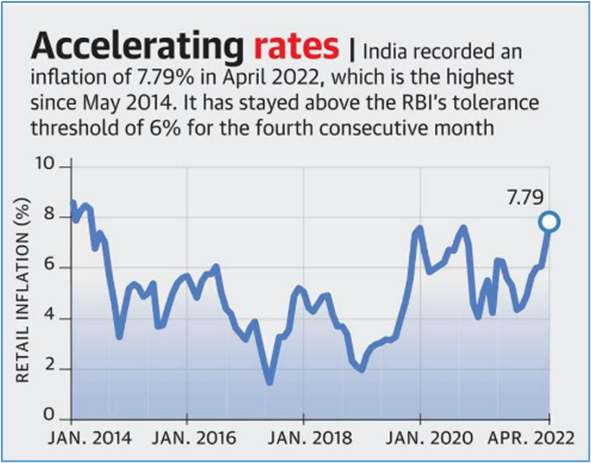Tuesday, 17th May 2022
Wheat Export ban in India
In News
Global wheat prices hit record high after India's ban on export.
About the News
- The Central government has banned wheat exports with effect from May 13, with some minor exceptions for those who have irrevocable letters of credit or where the governments of importing countries request the Indian government for food security purposes.

-
- Previously India had said that it was ready to help fill some of the supply shortages caused by the invasion of Ukraine, which had accounted for 12 percent of global exports.
- Recently, Egypt and Turkey placed orders in India for Wheat.
- India was looking for more deals with Morocco, Tunisia, Indonesia, Philippines, Thailand, Vietnam, Turkey, Algeria and Lebanon for exploring possibilities of boosting wheat exports from India.
- India is the world’s second-largest wheat grower after Russia.
- Before the export ban, India was set be in the top ten wheat exporters for 2022-23.
Reasons for the ban
- Inflation: India’s consumer price index hit an eight-year high of 7.79% in April while retail food inflation surged past 8.38%. Export ban may help temper rising food prices.
- Low yield of Wheat Crop: The heat wave conditions in India has led the government to revise wheat production estimates by 5.7 per cent in the 2021-22 crop year ending June.
- Poor Procurement of Wheat: Procurement of the cereal by government agencies has plunged to a 15-year-low. This is due to low yield of wheat crop and higher prices offered by private traders and exporters.
- Consumer bias in Policy: The export ban reflects a deep-rooted consumer bias in India’s trade policies. The government seeks to lower inflation rates at the cost of better returns to the farmers, as observed by experts.
Effects of the ban
- India’s ban on wheat exports has raised international prices by almost 6 per cent a bushel when global markets opened.
- Locally, prices dropped sharply by 4-8 per cent in different states— Rs 200-250 a quintal in Rajasthan, Rs 100-150 a quintal in Punjab, and about Rs 100 a quintal in Uttar Pradesh.
- Research analysts said the impact of India’s export ban would be felt disproportionately by low income developing countries like Bangladesh, the biggest buyer of Indian wheat.
- G7 agriculture ministers meeting in Germany said that such measures "would worsen the crisis" of rising commodity prices.
Alternative measures
- Government could have announced a bonus on top of MSP to augment its wheat procurement.
- Pradhan Mantri Garib Kalyan Ann Yojana (PMGKAY) could have substituted money in place of food rations, enabling beneficiaries to buy according to their needs over and above the PDS supplies.
- A Minimum export price (MEP) could have been set for wheat to disincentivise the traders instead of a blanket ban.
Sources:
- Chaos in Kandla after ban: 4,000 wheat trucks in queue, 4 ships half-full
- Explained: Why ban of wheat exports is knee-jerk reaction, hits farmers and dents policy credibility
- Export ban shakes world markets, wheat prices up 6%
- Global wheat prices hit record high after India's ban on export
- Wheat prices hit record high after India export ban
- India’s abrupt wheat ban is yet another instance of shoddy policymaking that disregards consequences
Places of Worship Act
In News
The Supreme Court will be hearing a challenge to the order of a civil court in Varanasi directing a videographic survey of the Gyanvapi mosque complex.
About the News
- The Committee of Management of Anjuman Intezamia Masjid is the organisation that has filed the appeal.
- The principal contention of the organisation is that the order of the Varanasi court-which was upheld by Allahabad High Court recently is “clearly interdicted (prohibited)” by The Places of Worship (Special Provisions) Act, 1991.
The Places of Worship (Special Provisions) Act, 1991
- What is it? It is “An Act to prohibit conversion of any place of worship and to provide for the maintenance of the religious character of any place of worship as it existed on the 15th August, 1947, and for matters connected therewith or incidental thereto.”
- Section 3 of the Act bars the conversion, in full or part, of a place of worship of any religious denomination into a place of worship of a different religious denomination or even a different segment of the same religious denomination.
- Section 4(1) declares that the religious character of a place of worship “shall continue to be the same as it existed” on August 15, 1947.
- Section 4(2) says that any suit or legal proceeding with respect to the conversion of the religious character of any place of worship existing on August 15, 1947, pending before any court, shall abate and no fresh suit or legal proceedings shall be instituted.
- Section 5 stipulates that the Act shall not apply to the Ramjanmabhoomi-Babri Masjid case, and to any suit, appeal or proceeding relating to it.
- History behind the Act: The Act was brought at a time when the Ram temple movement was at its peak.
- It was considered necessary to adopt it in view of the controversies arising from time to time with regard to conversion of places of worship which tend to vitiate the communal atmosphere.
- Its adoption was believed to effectively prevent any new controversies from arising in respect of conversion of any place of worship.
- Grounds on which the Law is challenged: The law has been challenged in various instances on the ground that it bars judicial review, which is a basic feature of the Constitution, imposes an “arbitrary irrational retrospective cutoff date”, and abridges the right to religion of Hindus, Jains, Buddhists and Sikhs.
Source:
- Explained: What is the Places of Worship Act, and what are its provisions?
- The Gyanvapi Mosque Case, the Places of Worship Act & Connected Concerns
Image source:
Iron fortified rice
In News
Excess iron has been found in fortified rice distributed through Jharkhand government schemes
About the News
- A report has highlighted that the excess iron can cause health issues in large tribal populations ailing from sickle cell anaemia, thalassemia and tuberculosis.
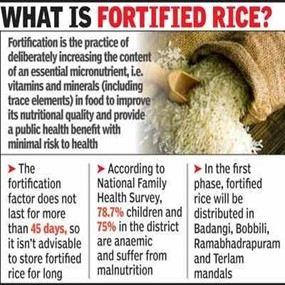
-
- Jharkhand is an endemic zone of sickle cell disorder and thalassemia, with a prevalence of 8%-10%, which is twice the national average.
- Thalassemia, sickle cell anaemia and malaria are conditions where there is already excess iron in the body, whereas TB patients are unable to absorb iron.
- Impact: Consumption of iron-fortified foods among patients of these diseases can reduce immunity and the reduce functionality of organs.
- The findings stress on need to immediately stop the distribution of iron fortified rice as a “silver bullet” to curb anaemia in the State, as an overload of iron can create adverse health issues.
What are the major findings of the report?
- Lack of consent: The report finds that the fortified rice is being distributed under Central government-funded schemes such as the public distribution system (PDS); PM-Poshan (erstwhile mid-day meal scheme) at schools; and Integrated Child Development Services (ICDS or anganwadi services) without the consent being obtained from beneficiaries.
- Lack of information: PDS dealers and frontline workers too have not been informed beforehand about the potential harmful effects of fortified rice for certain categories of the population.
- Layering of schemes: Cascading of different government schemes, such as the distribution of iron-folic acid tablets at anganwadi centres and schools as well as iron fortified salt in some States has led to excessive consumption of iron leading to health risks.
- Poor diagnosis: Among the beneficiaries who received fortified rice in the State were also patients diagnosed with thalassemia, sickle cell disease, and tuberculosis, and there may be many more who have been not diagnosed yet.
- Denial of basic rights: The Right to Informed Choices about one’s food is a basic right. The right to know what one is consuming is also a basic right. In the case of rice fortification, it is seen that no prior informed consent was ever sought from the recipients.
- Violation of FSSAI mandates: The Food Safety and Standards Authority of India’s (FSSAI) Food Safety and Standards (Fortification of Foods) Regulations 2018 require that fortified food packets must mandatorily display the fortification logo (+F), and that every package of food fortified with iron shall carry a warning statement that people with thalassemia may consume it under medical supervision, and persons with sickle cell anaemia are advised not to consume iron fortified food products.
- Violation of norms: Often, these warnings were missing from gunny sacks, and even when they were present, they carried little import as rice is often distributed loosely or without packaging in the PDS.
- Inter-mixing: There are also instances of women cooking the rice, including in schools and anganwadis, picking out by hand and discarding the fortified rice kernels that are mixed with regular rice kernels as they are easily identifiable, and referred to them as “plastic rice”.
Sources:
Edward Jenner
On May 17, 1749 Edward Jenner was born. He was an English surgeon and discoverer of vaccination for smallpox. The origin of smallpox is unknown. The finding of smallpox-like rashes on Egyptian mummies suggests that smallpox has existed for at least 3,000 years.

One of the first methods for controlling smallpox was variolation, a process named after the virus that causes smallpox (variola virus). Jenner’s discovery was a huge medical breakthrough; in 1980, the World Health Organisation declared the dangerous disease smallpox an eliminated disease. Today Edward Jenner is known as the "Father of Immunology".
Sources:
Subsidy on fertilizers
In News
An inter-ministerial committee has recently recommended revision of nutrient-based subsidy rates for nutrients nitrogen, phosphorous, potassium and sulphur for kharif 2022.
About the News
- In Union Budget 2022-23, the government allocated amount of Rs 1.09 lakh crore for fertiliser subsidy — Rs 42,000 crore for P&K fertiliser and Rs 67,187 lakh crore for urea.
- The new rates will be based on average international prices of fertilizers in March 2022 as a special case this year.
- Assurance of revised subsidy in line with the surge in global prices and is expected to calm the market which has seen worries of protracted disruptions in key commodities that has rattled global commodity and financial markets post Ukraine crisis.
What is fertiliser subsidy?
- Mechanism: The subsidy goes to fertiliser companies, although its ultimate beneficiary is the farmer who pays MRPs less than the market-determined rates.
- Beneficiary: Farmers buy fertilisers at MRPs (maximum retail price) below their normal supply-and-demand-based market rates or what it costs to produce/import them.
- Urea fertilisers: The MRP of neem-coated urea is fixed by the government at Rs 5,922.22 per tonne, whereas its average cost-plus price payable to domestic manufacturers and importers comes to around Rs 17,000 and Rs 23,000 per tonne, respectively.
- Non-urea fertilisers: The MRPs of non-urea fertilisers are decontrolled or fixed by the companies. The Centre, however, pays a flat per-tonne subsidy.
What are the major findings of the panel?
- Demand and supply: According to the fertilizer department, against the total estimated fertiliser requirement of 354.34 lakh tonne during the 2022 kharif season, availability would be 485.59 lakh tonne, including imported and domestically manufactured fertilizer.
- Surge in prices: As per market stats the international prices of fertilizers and raw materials have been constantly rising since January 2021.
- Price burden: In the case of non-urea fertilizers like phosphorous and potash, where the subsidy component is fixed, an increase in cost would translate to the retail price paid by the farmer, unless the subsidy is increased.
- Major factors: Reduction in phosphorous exports from China and Russia-Ukraine war have contributed to a price surge globally in recent times.
- Climate factor: Fertilizer supply concerns have come in the backdrop of a heat stress which is affecting North Indian farmers, impacting wheat output.
What are the Challenges faced by the sector?
- Heavy imports due to lack of domestic production: India is a large agricultural hub around the globe and yet majority of the total demand for fertilizer is met by imports.
- Poor infrastructure: A major portion is being imported because there haven’t been any breakthrough advances in the technologies used in the industry coupled with high production cost.
- Low Yield Due to Wrong Usages of NPK: The way Government is advancing farming, it has turned into a round of just three chemicals-NPK (nitrogen, phosphorus and potassium).
- Over usage: The greatest challenge in agriculture is the over usage of fertilizers. Urea being modest to buy is utilized by farmers increasingly that makes irregularity because of which the yield goes down.
- Over exploitation: In 1950, with the utilization of less NPK, the yield was more. Presently, with the utilization of more NPK, lesser yield is being delivered. There is a need to enhance the organic element of the soil through natural farming.
- Raw Material Availability and Pricing: The primary cause of fertilizer price fluctuations is related to the supply and demand factors.
- Poor resources: India faces a handicap due to lack of natural resources required to produce fertilizers. In case of urea, there is not enough natural gas available in the country.
- Input tax burden: Farmers are taxed on other inputs including diesel cost and in addition, farmers pay goods and service tax (GST) on inputs, ranging from 12% on tractors, agricultural implements, pumps and drip/sprinkler irrigation systems to 18% on crop protection chemicals.
- No tax reclaims: Fertiliser itself is taxed at 5%. Since there’s no GST on farm produce, they cannot claim any input tax credit on their sales, unlike other businessmen.
- Distributors and Retailers: The demand for specialty fertilizers is growing at a very fast rate. While the overall sales for various grades of water-soluble fertilizers are growing at a significant pace, yet some companies in the Indian market are facing major challenges due to the decline sales in the respective grade.
Government Efforts to support the Sector
- Concession Scheme for P&K Fertilizers: The main purpose of this Scheme is to provide P&K fertilizers to the farmers at affordable prices and to increase the food products in the country through the balanced use of fertilizers.
- To ensure a reasonable rate of return on the investments made by the entrepreneurs in the fertilizer sector.
- Nutrient Based Subsidy (NBS): Under the NBS Policy, a fixed rate of subsidy (on Rs. per Kg basis) is announced on nutrients like Nitrogen (N), Phosphate (P), Potash (K), and Sulphur (S) by the Government on annual basis.
- At present 22 grades of P&K fertilizers namely DAP, MAP, TSP, MOP, Ammonium Sulphate, SSP and 16 grades of NPKS complex fertilizers are covered under the NBS Policy. MRP of P&K fertilizers has been left open and fertilizer manufacturers or marketers are allowed to fix the MRP at reasonable rates.
- New payment system: Being super-subsidised, urea is always prone to diversion for non-agricultural use — as a binder by plywood/particle board makers, cheap protein source by animal feed manufacturers or adulterant by milk vendors — apart from being smuggled to Nepal and Bangladesh.
- DBT: In an attempt to curb such diversions, the government has proposed Direct Benefit Transfer through POS machines and subject to the buyers’ biometric authentication to beneficiaries.
Conclusion: The time has come to seriously consider paying farmers a flat per-acre cash subsidy that they can use to purchase any fertiliser. The amount could vary, depending on the number of crops grown and whether the land is irrigated or not. This is, perhaps, the only sustainable solution to prevent diversion and also encourage judicious application of fertilisers, with the right nutrient (macro and micro) combination based on proper soil testing and crop-specific requirements.
Question: Fertilizer subsidy is an important component of Indian agriculture. Discuss. What are the challenges faced by fertiliser sector?
Sources:
Sawa Lake
This is image of Iraq’s unique Sawa lake, which has dried up recently. The Sawa Lake, a biodiverse wetland situated near the city of Samawa, south of the capital Baghdad, has disappeared.

The lake is totally dry and only a pond remains where tiny fish swim. Bottles and plastic bags litter its former banks. The five-square-kilometre (two-square-mile) lake has been drying up since 2014. The causes have been climate change and rising temperatures. More than 1,000 wells illegally dug for agriculture in the area. Additionally, nearby cement and salt factories have drained significant amounts of water from the groundwater that feeds the lake. The Ramsar Convention on Wetlands, a global treaty, recognised Sawa as "unique” because it is a closed water body in an area of sabkha (salt flat) with no inlet or outlet.
Sources:
International Migration Review Forum
- Context: The First International Migration Review Forum (IMRF) will be held shortly under the auspices of the General Assembly at the United Nations in New York.
- IMRF will serve as the primary inter-governmental global platform to discuss and share progress on the implementation of all aspects pertaining to migration and its intersection with the Sustainable Development Goals (SDGs).
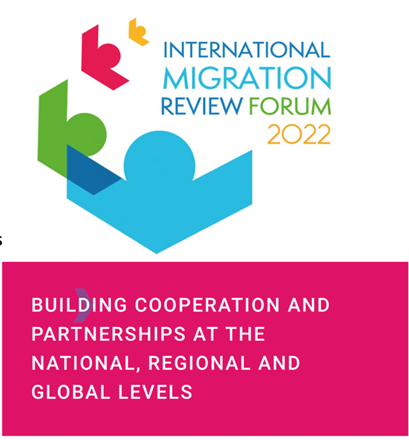
- Beginning in 2022, it shall take place every four years.
- The goal of the forum is to review the progress made at the local, national, regional and global levels in implementing the Global Compact for Safe, Orderly and Regular Migration (GCM.
- GCM is first inter-governmentally negotiated agreement, prepared under the auspices of the UN, covering all dimensions of international migration in a holistic and comprehensive manner.
- GCM is a non-binding document that respects states’ sovereign right to determine who enters and stays in their territory and demonstrates commitment to international cooperation on migration.
- IMRF is open to the participation of all UN Member States and all members of specialized agencies that have observer status with the General Assembly.
- It consists of four interactive multi-stakeholder round-tables, a policy dialogue and a plenary.
- The Minister of State for External Affairs will lead the Indian Delegation to the forum.
Source:
- About the Forum
- GLOBAL COMPACT FOR MIGRATION
- MoS External Affairs V Muraleedharan to lead Indian delegation for First International Migration Review Forum
Image source:
Ramgarh Vishdhari Tiger Reserve
- Context: Ramgarh Vishdhari Wildlife Sanctuary has been recently notified as a Tiger reserve
- Ramgarh Vishdhari is located majorly in Bundi district and a part in Bhilwara and Kota districts, and is a major corridor connecting tigers of Ranthambore and Mukundra reserves.
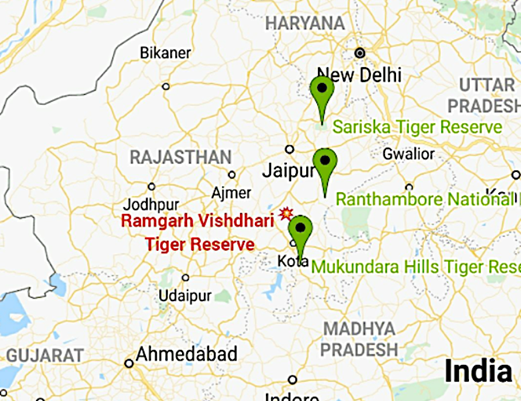
- It is now India’s 52nd tiger reserve and Rajasthan’s fourth, after Ranthambore, Sariska and Mukundra.
- The reserve includes the tiger habitat between Ranthambore Tiger Reserve in the northeast and Mukundra Hills Tiger Reserve on the southern side.
- The State Governmenton the recommendation of the National Tiger Conservation Authority (NTCA), notifies an area as a tiger reserve after consulting the concerned Gram Sabha and expert committee, in the exercise of its powers under Section 38F of the Wildlife Protection Act 1972.
Source:
- India’s 52nd tiger reserve, Ramgarh Vishdhari notified
- Rajasthan's Ramgarh Vishdhari Sanctuary notified as tiger
- Times of India
Image source:
India's position in remittances
- Context: According to the World Bank's report on migration and development, India has become the world’s largest recipient of remittances receiving USD 89 billion.
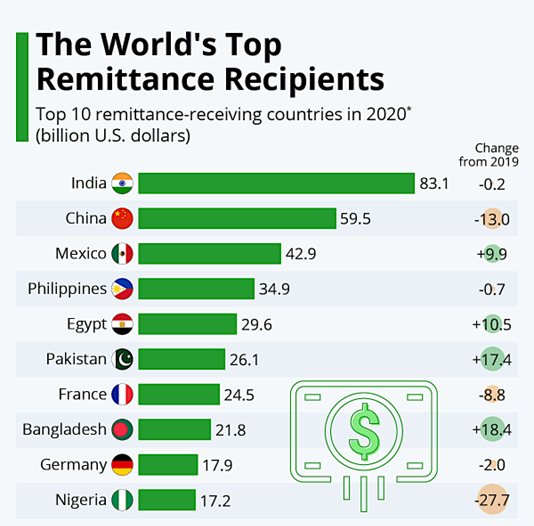
- Remittance refers to the money that is sent or transferred to another party, usually overseas, through wire transfer, electronic payment system, mail, draft, or cheque.
- Beneficiaries in India can receive cross-border inward remittances through banking and postal channels.
- The most common arrangements under which the remittances are received into the country are through Rupee Drawing Arrangement (RDA) and Money Transfer Service Scheme (MTSS).
- Banks have general permission to enter into a partnership with other banks for conducting remittance business.
- The International Financial System (IFS) platform of Universal Post Union (UPU) is generally used for the postal channel.
- The United States has sent the maximum inward remittance to India at USD 68 billion in 2020, followed by UAE (USD 43 billion) and Kerala is said to receive the highest amount of remittances.
Source:
- Remittances [Money Transfer Service Scheme (MTSS) and Rupee Drawing Arrangement (RDA)]
- WHAT IS REMITTANCE?
- Indian diaspora largest in the world, 18 million living outside India in 2020, says UN According to a UN report, the largest numbers of migrants from India
- Bangladesh 7th highest recipient of foreign remittance: World Bank
- This Indian State Receives The Highest Remittance
Image source:
Quad Vaccine Initiative
- Context: The inaugural delivery of vaccines against Covid-19 under the Quadrilateral Security Dialogue’s vaccine partnership was made in Cambodia recently.

- The Quad Vaccine Partnership was announced by the Quad Leaders at their first summit in 2021.
- It aims to leverage Quad’s collective strength to ensure global availability of safe and effective vaccines by expanding manufacturing and assisting countries in the Indo-Pacific with vaccination.
- Under this initiative, the Quad countries have agreed to provide over 2 billion doses of Covid vaccines globally.
- In this perspective:
- Quad countries have also provided last-mile delivery assistance to ensure that vaccines are translated into vaccinations.
- Australia and Japan have provided cold storage equipment, freezers and temperature monitors along with equipment for the safety of health care workers.
- The US has provided assistance with surveillance and contact tracing, case investigation, training health care workers and data management.
- The initiative will be implemented by a senior-level Quad Vaccine Experts Group, comprised of top scientists and officials from the governments.
Source:
Image source:
Bridge to the Buddha: Indian Express
Essence: The editorial provides a political perspective into Indian PM’s visit to Lumbini in Nepal. Lumbini happens to be the birthplace of Gautam Buddha, and India has initiated the creation of International Buddhist Conference and Meditation Center at the location. This has been considered as a delayed response to Chinas activism and building deep cultural and infrastructure inroads in Nepal. China offered to build Lumbini as the World Peace City and a monastery in core area of Lumbini, hardly 10kms from Indian border.
Nepal seems to be a microcosm, receiving competing investments from India, China and western nations. India has attempted to repair the bilateral ties which deteriorated after 2015 and Nepal’s promulgation of new constitution. Trade, energy and infrastructure projects and cultural ties form a part of the same.
Why should you read this article?
- To know about PM’s visit to Lumbini
- To understand why Nepal has become a microcosm for investment.
Source:
Better South Asian Neighborhood: Indian Express
Essence: The editorial speaks about how India is bound by the geography and historical relationship with its neighbors. Whether it be confidence levels or insecurity between the nations, both have been contributed to, by interlinkages of relationships.
India has hosted Tibetan refugees and freedom movement initiated by Dalai Lama, trained Sri Lankan Tamil rebels, helped Nepal’s Prachanda and Myanmar’s Aung San Suu Kyi as well. On the other hand, it has led to levels of insecurity between nations too.
Religion and culture are deeply connected in south Asia. Building of tourist circuit with Nepal, Kartarpur corridor with Pakistan with immense possibilities in Ramayana trail and Sufi shrines. What’s needed is to have interconnected trade relationship, rather than “imported government”, be it USA or China in our neighborhood.
The present times demand greater collaboration during times of international and economic crisis, inflation, etc.
Why should you read this article?
- To know the interconnectedness of culture in south Asia and how to promote the same.
Source:
Mundka fire is a symptom of all that ails the informal sector: Indian Express
Essence: Devastating fire at Delhi’s Mundka has once again brought to the fore challenges faced by informal sector workers, particularly female workers and apathy of employer and administration. After every such incident, absence of adherence to building norms and other safety related norms is flagged without any significant step taken to address it afterwards.
Workers, including female workers, are forced to work under poor conditions. Female workers particularly are forced to join low paying unskilled jobs in the informal sector because of their migrant status and poor economic conditions amplified by the pandemic. Utter disregarding labour laws related to safety, working hours, maternity leaves and basic facilities is flagrant.
Without any accountability of employers and a lack of political will to improve working conditions, we might end up allowing many more such horrific accidents.
Why should you read this article?
- To understand the condition of informal sector workers, particularly female workers.
- To find example of human right violations and administrative failure to quote in exam,
Source:
POSHAN PHERE
Background
Over 100 couples were married lately in Chhattisgarh under the Mukhya Mantri Kanaya Vivah Yojna (MKVY), a state-sponsored communal wedding event, with POSHAN Phere being the centrepiece of the occasion.
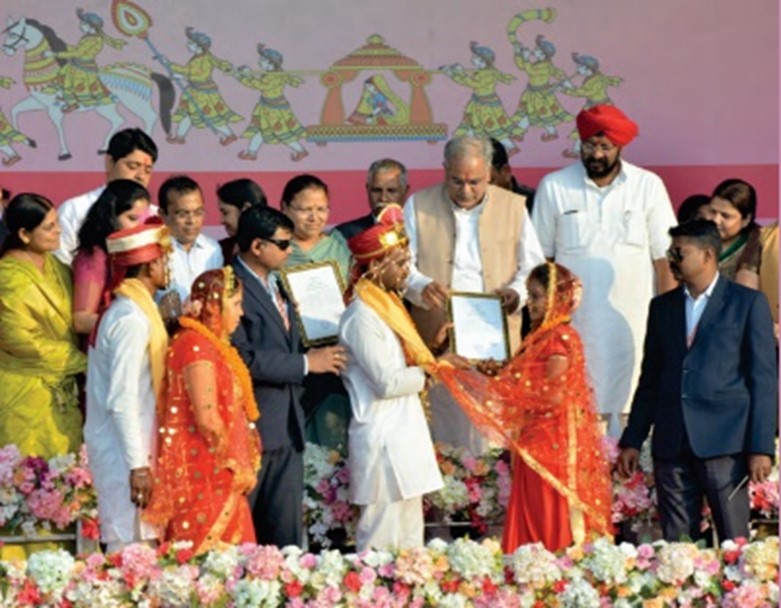
About Poshan Phere
- The couples married under this programme take an additional oath under which they promise health and well-being of their future kid by taking care of their own health, particularly women's health.
- It is commonly understood that an undernourished mother would always give birth to an undernourished child, sustaining an intergenerational cycle of malnutrition.
- Typically, family health messaging is aimed at women, but Poshan Phere includes both men and women.
- Men are key players in ensuring women's health is prioritised in the family, and when they take an oath with this in mind, mother and child health becomes everyone's responsibility.
- This is supported by the municipal and state governments, lending extra legitimacy to the matter. It works because it takes advantage of social norms and delivers the message to the appropriate people at the right time.
Quote: “Communities and countries and ultimately the world are only as strong as the health of their women.” – Michelle Obama
Source:
Share the article
Get Latest Updates on Offers, Event dates, and free Mentorship sessions.

Get in touch with our Expert Academic Counsellors 👋
FAQs
UPSC Daily Current Affairs focuses on learning current events on a daily basis. An aspirant needs to study regular and updated information about current events, news, and relevant topics that are important for UPSC aspirants. It covers national and international affairs, government policies, socio-economic issues, science and technology advancements, and more.
UPSC Daily Current Affairs provides aspirants with a concise and comprehensive overview of the latest happenings and developments across various fields. It helps aspirants stay updated with current affairs and provides them with valuable insights and analysis, which are essential for answering questions in the UPSC examinations. It enhances their knowledge, analytical skills, and ability to connect current affairs with the UPSC syllabus.
UPSC Daily Current Affairs covers a wide range of topics, including politics, economics, science and technology, environment, social issues, governance, international relations, and more. It offers news summaries, in-depth analyses, editorials, opinion pieces, and relevant study materials. It also provides practice questions and quizzes to help aspirants test their understanding of current affairs.
Edukemy's UPSC Daily Current Affairs can be accessed through:
- UPSC Daily Current Affairs can be accessed through Current Affairs tab at the top of the Main Page of Edukemy.
- Edukemy Mobile app: The Daily Current Affairs can also be access through Edukemy Mobile App.
- Social media: Follow Edukemy’s official social media accounts or pages that provide UPSC Daily Current Affairs updates, including Facebook, Twitter, or Telegram channels.


